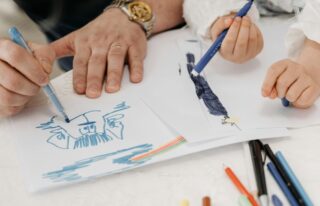This website uses cookies so that we can provide you with the best user experience possible. Cookie information is stored in your browser and performs functions such as recognising you when you return to our website and helping our team to understand which sections of the website you find most interesting and useful.
-
Free shipping on orders over €70
-
Order before 23:00, shipped same day
-
Premium support 09:00-17:00 (mo-fri)
Be Ambidextrous, Boost Your Brain

Be Ambidextrous, Boost Your Brain
IN THIS ARTICLE
IN THIS ARTICLE
LISTEN TO THIS ARTICLE
Be Ambidextrous, Boost Your Brain
The word “ambidextrous” comes from Latin: “ambi” meaning “both” and “dexter” meaning “right” or “skilful.”
In other words, it’s the ability to use each hand as easily as the other regardless of the task.
A small handful (pun intended) of people can do most tasks with both hands, but it’s far from the majority of us.
In fact, neuroscience tells us that being ambidextrous is so much more than just a cool trick.
In fact, we can boost our brain’s cognitive precision by practicing the art of using both hands, i.e. boosting neuroplasticity in real time.
When we challenge ourselves to use our non-dominant hand, we’re not just improving coordination; we’re literally rewiring our brain’s architecture, promoting neuronal growth, and reorganise existing ones.
The Science Behind Brain Plasticity
Each time we perform an unfamiliar action, our brain creates new synaptic connections. These connections, when repeatedly activated, become stronger and more efficient, much like turning a narrow trail into a well-traveled path.
Neuroplasticity extends far beyond just learning new skills. We’re actually creating new neural pathways, increasing synaptic density, and enhancing overall brain connectivity.
This process of building new connections while strengthening existing ones is what makes our brains more resilient and adaptable over time.
Daily Challenges for Neural Growth
Start simple with everyday tasks using your non-dominant hand.
The key is to gradually introduce these challenges into your routine and notice how quickly you improve.
Morning Routine Using Non-dominant Hand:
- Try brushing your teeth
- Then try brushing your and then styling it. Yes, it’s frustrating at first and definitely more time-consuming, but it’s also worth testing it.
- Then try applying your skincare products and/or makeup. The precision required here really challenges your fine motor skills (disclaimer; also a wee bit time consuming)
Your Non-Dominant Hand Throughout the Rest of the Day:
- Unlock doors, open cabinets, and drawers
- Use your phone or computer mouse differently
- Write your to-do lists or journal entries
- Pick up your coffee cup or water bottle
- Use utensils during meals
- Send text messages or type emails
Each awkward moment is actually super valuable and humbling. It reminds us how much we take for granted when it comes to our motor skills and how it feels to be an absolute beginner.
In a very short amount of time, you will notice how the clumsy non-dominant hand becomes fluid, elegant and smoother. This is not only so very satisfying but pure evidence of neuroplasticity at work!
Digital Neuroplasticity: The App Challenge
Here’s a fascinating fact: we tap, swipe, and click our phones over 2,600 times per day on average. Think about that – 2,600 automatic movements that our brain has perfectly memorised. Geez!
Now try this: reorganise your phone apps every few months.
Notice how quickly your fingers try to move in their habitual patterns, reaching for apps in their old locations.
This automatic response will show you in real-time how second nature our digital movements are wired into our neural pathways.
So I am encouraging you to force your brain to create new pathways and not just run on autopilot. It might even help you put the phone down and do something else that doesn’t involve a screen. WIN!
The 30-Day Challenge
Here’s a very tangible way to track your brain’s plasticity:
Start by writing a paragraph with your non-dominant hand and take a photo.
Practice daily for one month, just 3-5 minutes a day then compare your Day 1 and Day 30 handwriting.
The improvements will astound you!
Ready to take your brain training to the next level? Start today by taking a photo of your non-dominant handwriting and then again in 30 days. Then be sure to share the photos with me on our socials.
I can’t wait to see your progress!
You can find me here:
- Facebook group (8.000+ members)
- Discord channel (2.000+ members)
- Follow us on Instagram @microdosepro.amsterdam and @humanpro.amsterdam
- Follow me on Instagram @asha_md_coach
As always,
Shine bright. Do good. Flow strong.
Asha ✨

